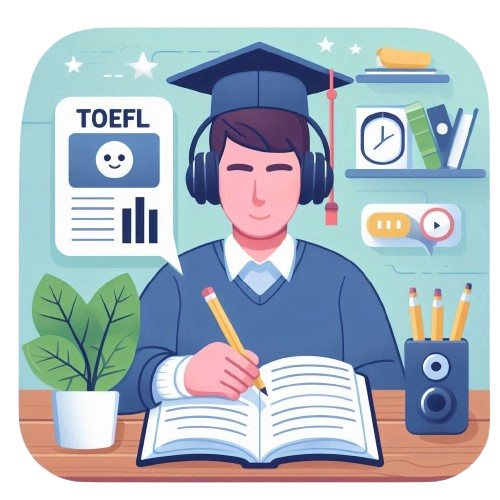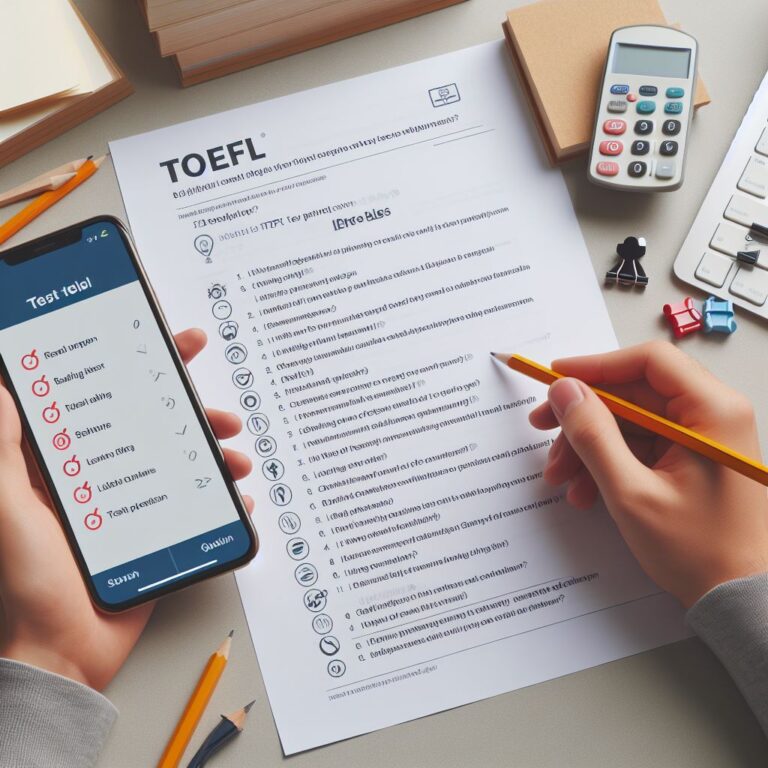TOEFL Listening: The Ultimate Guide

Key Points
- TOEFL listening consists of academic lectures and conversations related to university life.
- Lectures cover various freshman-level academic disciplines, while conversations typically involve student interactions with professors or university staff on administrative matters.
- Test-takers must rely on memory and note-taking since they cannot re-listen to the recordings.
- Effective preparation involves understanding these question types, identifying personal strengths and weaknesses, and practicing without relying on transcripts to improve listening comprehension.
What you will find in this guide:
TOEFL Listening
The TOEFL iBT test is a comprehensive examination that assesses your proficiency in English, and the Listening section plays a crucial role in this assessment12. TOEFL listening tests your understanding of spoken English and your ability to answer questions about the conversations and lectures you hear2. This might sound daunting, but don’t worry! With the right preparation and understanding, you can excel in this section.
The Listening part of TOEFL is the second part of the TOEFL iBT test2. It includes listening for basic comprehension, understanding the speaker’s attitude and degree of certainty, and connecting information1. You’ll hear lectures and conversations in this section, all using language you would typically encounter on a university campus1.
In this blog post, we’ll delve deeper into the structure of the Listening section, the types of questions you’ll encounter, and the strategies you can employ to ace this part of the test. So, buckle up and get ready for a comprehensive guide to mastering the TOEFL Listening section!
Stay tuned for the next sections where we’ll discuss the TOEFL Listening section in more detail, including its format, preparation tips, and test-taking strategies. Remember, the key to success in the TOEFL Listening section, as with any test, is understanding the format, practicing regularly, and approaching the test with confidence.
The Structure
The TOEFL Listening section is the second part of the TOEFL iBT test. It’s designed to measure your ability to understand conversations and lectures in English1. This section tests your listening skills at an academic level, and it’s structured to reflect the kind of listening and understanding you’ll need to do in a university setting.
Here’s a detailed breakdown of the structure of the TOEFL Listening section:
- Number of Recordings: The TOEFL iBT Listening test is composed of six recordings3.
- Types of Recordings: The recordings are a mix of academic lectures and conversations23.
- Lectures: There are 3 to 4 academic lectures, each ranging from 3 to 5 minutes in length23. Each lecture is followed by 6 questions2.
- Conversations: There are 2 to 3 recorded student or teacher conversations, each ranging from 2 to 3 minutes in length23. Each conversation is followed by 5 questions2.
- Question Types: The questions on the TOEFL Listening test evaluate comprehension, but also information synthesis and the ability to draw conclusions from what you have heard3.
- Test Time: It should take about 36 minutes to complete the Listening section2.
- Note-Taking: You can take notes on any audio item throughout the test to help you answer questions2.
- Accents: The Listening section includes native-speaker English accents from North America, the U.K., New Zealand, or Australia to better reflect the variety of accents you might encounter while studying abroad2.
Remember, each passage is played only once, but you’re allowed to take notes while listening1. You will not know the questions while you listen, and you will not be able to listen again to the full recording to check your answer choice. That means a good memory and good notes are key to giving the correct answer. (This is just as important as your listening skills!) You cannot change your answers after they are submitted—your only choice is to answer questions and go forward to the next questions. Sometimes, questions will deal with particular parts of the audio recordings, and the test will replay a small audio clip for you. This is only for certain questions, however, usually 0-2 per recording. After a set of five or six questions is finished, the next recording will start automatically.

Listening Topics and Tone
The lectures in the TOEFL Listening section can come from any academic discipline that can show up on the Reading section. In short, almost anything a freshman could take a class in, except math or mathematical sciences. The conversations are either between a student and a professor during office hours, or between a student and some member of support staff/university administration. Often the second kind of conversation deals with topics like course registration, graduation requirements, and financial aid. It helps to become familiar with the language and structure of university administration so you don’t get stuck on a Listening passage that takes place in a setting you’re unfamiliar with, such as, say, a registrar’s office.
Whereas the Reading section features very sterile, academic language, the Listening section is designed to mimic natural speech. This means that the speakers will pause, change sentences or topics abruptly, and occasionally say something incorrect or forget what they were talking about. You may be asked questions about these imperfections, so a familiarity with unrehearsed speech is essential to doing well in the Listening section. Unlike in the Official Guide, no part of the real Listening test will ever be transcribed for you. It’s important to do plenty of Listening practice without looking at the transcripts!
Many of the question types on the Listening section will look familiar to test takers who have seen the Reading section, but a few will deal with the unique ability of speech to convey information without words—through intonation and stress.
The Listening section will expose you to a variety of content both academic and non-academic. Even before the recording starts, your test will give you some idea of what kind of recording you’ll be listening to, which can help you to know what kinds of questions to expect.
Although all Listening excerpts are noticeably slower than natural speech, the speakers try to speak as naturally as possible. This means that they use all the “ums,” pauses, and sudden redirects that you would encounter in actual language. Not only do you need to be able to navigate these incidental cues, but you also need to be ready to comment on how they function in context, as you will probably have to answer at least one question on your test about the meaning of a byte of incidental language. Needless to say, pacing is key.
Type of Listening Audio
There are two basic types of TOEFL Listening audio tracks: lectures and conversations. Below, we’ll look at those track types in greater detail, with links to examples of each kind of track.
Lectures
The first type of Listening assignment is the lecture12. Lectures generally last about five minutes, and can be on a wide variety of topics including natural sciences, history, art, anthropology, and business/economics2. Each lecture will begin with a sentence like this example: “Listen to the following excerpt from a lecture in an introductory economics class”2.
There are two basic types of lecture: with students’ questions and without students’ questions2. When there are questions, it may be just one quick interruption or it could be a back-and-forth between the professor and multiple students, in a format similar to a conversation2. In either case, the content is the same: all lectures focus entirely on an academic topic and are set in a classroom2.
Every lecture is accompanied by six questions, and they may be of any type1. You will usually only see organization questions in lectures, so pay extra attention to the organization of any lecture you’re given2. Organization questions focus on the way spoken information is organized2.
Conversations
The conversation samples are shorter than the lectures, and they may contain academic or non-academic content13. They generally take place either between a student and a professor or between a student and someone in a support role at a university3. Conversations with a professor may include topics like assignment deadlines (non-academic content), clarification of course material (academic content), or upcoming assignments/projects (can be academic or non-academic content)2. Conversations with people in support roles include topics like registration, housing, and other logistical aspects of college life2. Some familiarity with the language and culture of American higher education will be helpful in understanding the conversations2.
Conversations usually last between three and five minutes, and are accompanied by five questions1. Conversations are less likely than lectures to have organization or detail questions, but you should expect more questions about attitude and function2.

TOEFL Listening Question Types
Let’s delve into the different types of questions you’ll encounter in the TOEFL Listening section. Understanding these question types is crucial for your success on the test54.
Detail Questions
Detail questions focus on understanding specific pieces of factual information1. They deal with specific facts from the Listening section, but they are not usually as specific as detail questions in the Reading section1. Because you don’t have the option of listening to the recording a second time, you will depend on the information that you wrote in your notes1. For this reason, detail questions in the Listening section rarely deal with very specific information like numbers or names1. Instead, they focus on those facts that you would recognize as important as you listened to the recording1.
Main Idea Questions
Main Idea questions aim at identifying the primary purpose of a conversation or lecture1. Every listening sample will begin with a main idea question1. These questions ask you to identify the main point of the lecture or conversation1. They usually take one of the following forms: Why does the professor ask to see the student? What problem does the student have? What is the main idea of the lecture?1
Inference Questions
Inference questions are about recognizing implied information1. They require you to read between the lines and understand what the speaker is implying but not directly stating1.
Organization Questions
Organization questions focus on recognizing the relationship between different pieces of information1. They are almost exclusively used for lectures1. You will usually only see organization questions in lectures, so pay extra attention to the organization of any lecture you’re given1.
Attitude Questions
Attitude questions are about inferring the speaker’s attitude or opinion1. They require you to understand the speaker’s feelings or attitudes towards the topic being discussed1.
Function Questions
Function questions are about understanding the reason a specific thing is said1. They require you to understand why a speaker said something1.
Categorizing Questions
Categorizing questions involve organizing ideas from the audio into categories based on their similarities and differences1.
Potential Challenges
During the TOEFL Listening section, you will face several significant challenges.
You will listen to the audio only once: You will only have one opportunity to listen to each audio track. This means you need to focus intensely the first time you hear the track because you won’t have a chance to listen to it again. It’s crucial to capture as much information as possible on the first go.
Too much information: The audio tracks will contain a large amount of information, designed to be dense and complex, with more details than you can realistically memorize. This can include facts, opinions, arguments, examples, and other nuanced information. The sheer volume of information can be overwhelming, making it difficult to retain everything.
Unknown questions: Another challenge is that you will not know the specific questions you will be asked until after the audio track has finished playing. This requires you to listen attentively to the entire audio, as any part of it could be relevant to the questions. You must stay engaged and try to understand and remember the overall context, main ideas, and key details.
Inference: Some questions will ask you to make inferences based on the audio. These questions are not just about recalling specific facts or details but understanding what is implied by the speaker. You need to interpret the speaker’s tone, attitude, and underlying meanings, going beyond the literal words to grasp the intended message.
Guide to TOEFL Listening
Step 1: Listen and Take Notes!
The TOEFL audio files will be played only once, and won’t be repeated. You won’t know what the questions will be so you will have no idea what you should focus on. Plus, there will be a lot of information to keep track of, so, you have to take notes!
Step 2: Start by reading the question!
Questions in the listening part could be tricky. So read the questions carefully. This will help you understand what the question is asking and what you need to look for in the paragraph.
Step 3: Identify the keywords of the question
After reading the question, Identify the keywords of the question to make sure you focus on what’s important and what you are supposed to find out. These are the words that are most important in the question and will help you focus on what’s relevant in the paragraph. By identifying the keywords, you can quickly scan the paragraph for the relevant information.
Step 4: Read the options
Read the options provided for the question. This will help you understand what the answer choices are.
Step 5: Refer to your notes
Make sure to refer to your notes to see what you information you have. Do not only trust your memory because we humans are fallible! Always corroborate the options provided for the question with the notes you have to make sure you will make the right decision.
Step 6: Eliminate two options that are obviously wrong
Eliminate the answer choices that are obviously wrong. This will help you narrow down your choices and increase your chances of getting the right answer.
Step 7: Choose between the remaining two options
Finally, use your logic and reasoning skills to choose between the remaining two options. Look for evidence in your notes that supports or contradicts each option. Choose the option that best matches what was stated or implied in the audio.
References
1. TOEFL iBT Listening Section (ets.org)
2. Introduction to the TOEFL listening section | BestMyTest
3. TOEFL listening | TOEFL | Guide to English exams | EF Global Site (English)
4. TOEFL Listening: Structure, Question Types, Tips, and Practice Tests (ieltsit.com)
5. The 7 TOEFL Listening Question Types (with sample questions) – Magoosh Blog – TOEFL®️ Test






